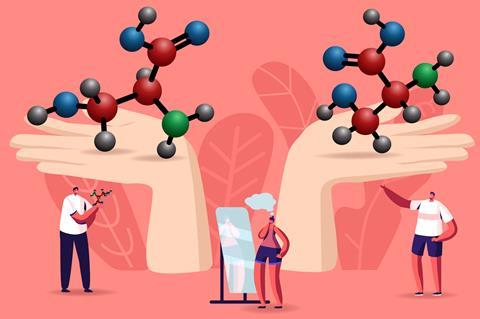Use gestures, movement and mental imagery to help students get to grips with stereoisomers
Chemistry students can find it difficult to understand and represent complex phenomena that are not visible to the naked eye. For example, when they need to visualise molecules in 2D and 3D, and transition between these two representations. The challenges are particularly apparent when students encounter stereoisomers. These molecules have the same molecular formula and sequence of bonds between atoms, but their atoms are oriented differently in 3D.

As part of a study, US researchers asked students to act out molecular rotations to see if it improved their understanding of stereoisomers. This involved a variety of activities where students were asked to use their imagination, gestures and physical movement to act out and visualise rotations. The researchers found these actions improved student performance.
The research team investigated different teaching strategies that actively engaged students in representing how stereoisomers move. Active learning approaches are widely used and well known, but the researchers were interested in whether engagement using the body was particularly effective. Research on ‘embodied cognition’, which links sensory and motor systems with cognitive processing, suggests it could be.
Using mental and physical rotations
Students from three different universities participated in the study. The 74 undergraduate participants were familiar with the traditional wedge-and-dash representations used in the study. The researchers randomly assigned students one of the three types of instruction: action, gesture or mental imagery.
Each type of instruction was designed to encourage students to actively represent the movement of molecules. Students in the action instruction group rotated physical models of molecules, while the gesture group performed gestures to visualise the rotation of molecules. Both involve motor action. To contrast these, the third type of instruction involved students imagining the rotation of molecules.
The students completed pre- and post-tests to determine any improvement based on the instructional activities. Importantly, the tests required both a correct drawing and a correct explanation, so student understanding was measured robustly.
Teaching tips
- The study’s testing and teaching resources are freely available on the Open Science Framework. Some of these could be used without modification, but you may want to adapt them for your own context.
- Reflecting on the three instruction methods may help you to refine your own teaching practice. Find more details about them in the research paper.
- As all three instruction techniques investigated were found to be similarly effective, you may want to choose what you use in your practice – with logistics being a potential factor here. For example, it might be too expensive to provide all students with models.
Teaching tips
- The study’s testing and teaching resources are freely available on the Open Science Framework (bit.ly/3yn3sLg). Some of these could be used without modification, but you may want to adapt them for your own context.
- Reflecting on the three instruction methods may help you to refine your own teaching practice. Find more details about them in the research paper.
- As all three instruction techniques investigated were found to be similarly effective, you may want to choose what you use in your practice – with logistics being a potential factor here. For example, it might be too expensive to provide all students with models.
The researchers found all three versions of the training improved performance and there was no statistical difference between the action, gesture or imagine groups. This supports the use of various instructional techniques involving active student engagement in this topic area.
Notably, only about 30% of participants improved their performance. This could be because some participants already had good prior knowledge, with little room for improvement, and/or because the instruction was short. This perhaps highlights the need to provide students with multiple opportunities to actively engage with the subject matter.
The researchers found no evidence of a difference in pre-test performance between boys and girls – and both benefitted equally from the instruction types. Some research literature has suggested there are gender-related differences in spatial skills that might contribute to a small differential performance in stereoisomer-based questions. This study suggests this is not an important consideration for these instructional techniques. However, the researchers note their study may not have been large enough to observe differences.
Fraser Scott
Reference
R Ping et al, Chem. Educ. Res. Pract., 2022, 23, 698–713 (DOI: 10.1039/D1RP00313E)
References
R Ping et al, Chem. Educ. Res. Pract., 2022, 23, 698–713 (DOI: 10.1039/D1RP00313E)









No comments yet